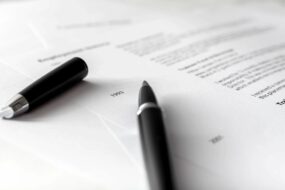Cover Letter Structure
Why Do I Write a Cover Letter?
A cover letter is typically your first contact with a perspective employer. It allows you to introduce yourself to the organization and make the connection between the position for which you are applying and your qualifications. A cover letter provides context to your resume and motivates the organization to interview you.
The 1, 2, 3 Structure of a Cover Letter
Each cover letter can use the same 3-paragraph structure. It is important to write a fresh cover
letter for each position for which you apply.
1st Paragraph
- Greeting – Address your cover letter to the hiring manager with a formal greeting (Dear Dr. Smith, Dear Ms. Smith) and if there is someone over Human Resources/Human Capital. If the hiring manager is not listed, see if you can locate the person’s name on the organization’s website. If that is not available, address it to the potential hiring person (Dear Department of Housing and Urban Development Hiring Manager). Avoid using generic greetings (To Whom It May Concern, Dear Sir or Madam).
- Indicate the specific position for which you are applying.
- Note how you heard about the position.
- Explain why you are interested in the position and working for the organization.
2nd Paragraph
- Specifically discuss what makes you unique to set yourself apart from the other candidates.
- Select the right experiences to highlight in your cover letter. Review the job description to see what the organization needs from this position. You want to speak to what you can do for them based on their needs.
- Connect your strengths, experiences, and education to the skills and experiences the organization is seeking.
- Avoid repeating what is already listed on your resume. Expand on what is in your resume and make connections for the reader between what they are seeking and what you have to offer. Think about how you would express something on your resume with an example. Let the reader see your passion for the type of work you do.
- Do not apologize for or highlight any experience you may not have yet. Make a connection between the experiences you do have and how that will make it possible for you to do the duties for which they are seeking.
3rd Paragraph
- Thank the person for reviewing your application and/or considering your resume.
- Indicate when you will follow-up on the status of your application and next steps
Cover Letter Physical Structure
[Date e.g., January 1, 2020]
Name, Credentials (if applicable)
Title
Organization
Address 1
Address 2 (if applicable)
City, State Zip Code
Dear [Name],
1st Paragraph
2nd Paragraph
3rd Paragraph
Best.
first name
[First name] [Last name], [Credentials, if applicable]
[ Email address, hyperlinked]
[Telephone #] (XXX) XXX-XXXX
Attachment: Resume
Before Sending Your Cover Letter…
- Read the cover letter out loud and proof for typos
- Use the “Check Document” feature in Microsoft Word to check for spelling, grammar, clarity and conciseness, formal language, and punctuation conventions.
- Ask at least one person to review for typos and clarity.
- Save the document as a PDF to send electronically. If sending via email, put the cover letter in the body of the email and attach the PDF.
- Review the organization’s instructions for how to provide the cover letter (email, recruiting website). Do not text a cover letter.
Cite: BSCorbett Consulting, LLC. (2020). Cover Letter Structure. Retrieved from http://https://bscorbettconsulting.com/portfolio/cover-letter-structure









